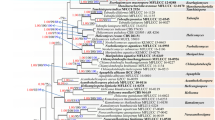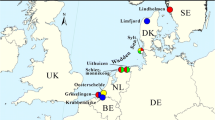Abstract
The genus Halophytophthora is a predominantly marine or estuarine genus of the oomycete family Peronosporaceae. This genus has been revealed as a highly polyphyletic assemblage of largely unrelated species. A new genus of the Peronosporaceae, Calycofera, is introduced in this manuscript to accommodate Halophytophthora operculata. Calycofera is distinct compared to Phytopythium s. str. and to Halophytophthora s. str. on the basis of sporangium morphology, sporangiogenous hyphae, and the development and release of zoospores. Phylogenetic analyses using ITS, cox2 and cox1 sequences strongly supported the establishment of this taxon. In addition, a second species of the genus was found, which is genetically more divergent from C. operculata than most sister species in the sister genus Phytopythium, and is described as C. cryptica based on diagnostic nucleotides.



Similar content being viewed by others
References
Abdul Baten M, Asano T, Motohashi K, Ishiguro Y, Rahman MZ, Inaba S, Suga H, Kageyama K (2014) Phylogenetic relationships among Phytopythium species, and re-evaluation of Phytopythium fagopyri comb. nov., recovered from damped-off buckwheat seedling in Japan. Mycol Prog 13:1145–1156
Allain-Boulé N, Tweddell R, Mazzola M, Bélanger R, Lévesque CA (2004) Pythium attrantheridium sp. nov.: taxonomy and comparison with related species. Mycol Res 108:795–805. doi:10.1017/S095375620400053X
Ann PJ, Ko WH (1980) Phytophthora insolita, a new species from Taiwan. Mycologia 72:1180–1185. doi:10.2307/3759572
Bachofer M (2004) Molekularbiologische populationsstudien an Plasmopara halstedii, dem falschen mehltau der sonnenblume. Dissertation, University of Hohenheim, Stuttgart
Bala K, Robideau GP, Lévesque CA, de Cock AWAM, Abad ZG, Lodhi AM, Shahzad S, Ghaffar A, Coffey MD (2010) Phytopythium Abad, de cock, Bala, Robideau, Lodhi and Lévesque, gen. nov. and Phytopythium sindhum Lodhi, Shahzad and Lévesque, sp. nov. Persoonia 24:136–137
Bennett RM, Thines M (2017) Confirmation that Phytophthora insolita (Peronosporaceae) is present as a marine saprotroph on mangrove leaves and first report of the species for the Philippines. Nova Hedwigia. doi:10.1127/nova_hedwigia/2017/0404
Bennett RM, Dedeles GR, Thines M (2017) Phytophthora elongata (Peronosporaceae) is present as an estuarine species in Philippine mangroves. Mycosphere 8:959–967. doi:10.5943/mycosphere/8/7/11
Chen XR, Liu BB, Xing YP, Cheng BP, Liu ML, Tong YH, Xu JY (2016) Identification and characterization of Phytopythium helicoides causing stem rot of Shatangju mandarin seedlings in China. Eur J Plant Pathol. doi:10.1007/s10658-016-0952-4
Choi YJ, Thines M (2015) Host jumps and radiation, not co-divergence drives diversification of obligate pathogens. A case study in downy mildews and Asteraceae. PLoS ONE. doi:10.1371/journal.pone.0133655
Choi YJ, Shin HD, Ploch S, Thines M (2011) Three new phylogenetic lineages are the closest relatives of the widespread species Albugo candida. Fungal Biol 115:598–607. doi:10.1016/j.funbio.2011.02.006
Choi YJ, Beakes G, Glockling S, Kruse J, Nam B, Nigrelli L, Ploch S, Shin HD, Shivas RG, Telle S, Voglmayr H, Thines M (2015a) Towards a universal barcode of oomycetes – a comparison of the cox1 and cox2 loci. Mol Ecol Resour. doi:10.1111/1755-0998.12398
Choi YJ, Klosterman SJ, Kummer V, Voglmayr H, Shin HD, Thines M (2015b) Multi-locus tree and species tree approaches toward resolving a complex clade of downy mildews (Straminipila, Oomycota), including pathogens of beet and spinach. Mol Phylogenet Evol 86:24–34
de Cock AWAM, Lodhi AM, Rintoul TL, Bala K, Robideau GP, Abad ZG, Coffey MD, Shahzad S, Lévesque CA (2015) Phytopythium: molecular phylogeny and systematics. Persoonia 34:25–39. doi:10.3767/003158515X685382
de Jesus AL, Gonçalves DR, Rocha SCO, Marano AV, Jerônimo GH, De Souza JI, Boro MC, Pires-Zottarelli CLA (2016) Morphological and phylogenetic analyses of three Phytopythium species (Peronosporales, Oomycota) from Brazil. Cryptogam Mycol 37:117–128. doi:10.7872/crym/v37.iss1.2016.117
Goodwin SB, Legard DE, Smart CD, Levy M, Fry WE (1999) Gene flow analysis of molecular markers confirms that Phytophthora mirabilis and P. infestans are separate species. Mycologia 91:796–810. doi:10.2307/3761533
Ho HH, Jong SC (1990) Halophytophthora, gen. nov., a new member of the family Pythiaceae. Mycotaxon 35:377–382
Ho HH, Chang HS, Hsieh SY (1991) Halophytophthora kandeliae, a new marine fungus from Taiwan. Mycologia 83:419–424. doi:10.2307/3760352
Hudspeth DSS, Nadler SA, Hudspeth MES (2000) A cox2 molecular phylogeny of the Peronosporomycetes. Mycologia 92:674–684. doi:10.2307/3761425
Hulvey J, Telle S, Nigrelli L, Lamour K, Thines M (2010) Salisapiliaceae – a new family of Oomycetes from marsh grass litter of southeastern North America. Persoonia 25:109–116. doi:10.3767/003158510X551763
Jung T, Burgess TI (2009) Re-evaluation of Phytophthora citricola isolates from multiple woody hosts in Europe and North America reveals a new species, Phytophthora plurivora sp. nov. Persoonia 22:95–110. doi:10.3767/003158509X442612
Jung T, Cooke DEL, Blaschke H, Duncan JM, Oßwald W (1999) Phytophthora quercina sp. nov., causing root rot of European oaks. Mycol Res 103:785–798. doi:10.1017/S0953756298007734
Katoh K, Misawa K, Kuma K, Miyata T (2002) MAFFT: a novel methodfor rapid multiple sequence alignment based on fast Fourier transform. Nucleic Acids Res 30:3059–3066
Lara E, Belbahri L (2011) SSU rRNA reveals major trends in oomycete evolution. Fungal Divers 49:93–100. doi:10.1007/s13225-011-0098-9
Man In ‘T Veld W, Rosendahl KCHM, Brouwer H, De Cock AWAM (2011) Phytophthora gemini sp. nov., a new species isolated from the halophilic plant Zostera marina in the Netherlands. Fungal Biol 115:724–732. doi:10.1016/j.funbio.2011.05.006
Marano AV, Jesus AL, de Souza JI, Leaño EM, James TY, Jerônimo GH, de Cock AWAM, Pires-Zottarelli CLA (2014) A new combination in Phytopythium: P. kandeliae (Oomycetes, Straminipila). Mycosphere 5:510–522
Mishra B, Ploch S, Weiland C, Thines M (2017) The TrEase web-server: Building and merging phylogenetic trees with ease. http://www.thines-lab.senckenberg.de/trease
Moncalvo JM, Wang HH, Hseu RS (1995) Phylogenetic relationships in Ganoderma inferred from the internal transcribed spacers and 25S ribosomal DNA sequences. Mycologia 87:223–238. doi:10.2307/3760908
Nigrelli L, Thines M (2013) Tropical oomycetes in the German bight – climate warming or overlooked diversity? Fungal Ecol 6:152–160
Pegg KG, Alcorn JL (1982) Phytophthora operculata sp. nov., a new fungus. Mycotaxon 16:99–102
Price MN, Dehal PS, Arkin AP (2009) FastTree: computing large minimum evolution trees with profiles instead of distance matrix. Mol Biol Evol 26:1641–1650. doi:10.1093/molbev/msp077
Price MN, Dehal PS, Arkin AP (2010) FastTree 2 – approximately maximum-likelihood trees for large alignments. PLoS ONE. doi:10.1371/journal.pone.0009490
Puglisi I, De Patrizio A, Schena L, Jung T, Evoli M, Pane A, Van Hoa N, Van Tri M, Wright S, Ramstedt M, Olsson C, Faedda R, Magnano di San Lio G, Cacciola SO (2017) Two previously unknown Phytophthora species associated with brown rot of Pomelo (Citrus grandis) fruits in Vietnam. PLoS ONE. doi:10.1371/journal.pone.0172085
Rea JR, Jung T, Burgess TI, Stukely MJC, Hardy GESJ (2010) Phytophthora elongata sp. nov., a novel pathogen from the Eucalyptus marginata forest of Western Australia. Australas Plant Pathol 39:477–491. doi:10.1071/AP10014
Robideau GP, de Cock AWAM, Coffey MD, Voglmayr H, Brouwer H, Bala K, Chitty DW, Désaulniers N, Eggertson QA, Gachon CMM, Hu CH, Küpper FC, Tl R, Sarhan E, Verstappen ECP, Zhang Y, Bonants PJM, Ristaino JB, Lévesque AC (2011) DNA barcoding of oomycetes with cytochrome c oxidase I and internal transcribed spaces. Mol Ecol Resour 11:1002–1011. doi:10.1111/1755-0998.12398
Ronquist F, Teslenko M, van der Mark P, Ayres DL, Darling A, Hohna S, Larget B, Liu L, Suchard MA, Huelsenbeck JP (2012) MrBayes 3.2: efficient Bayesian phylogenetic inference and model choice across a large model space. Syst Biol 61:539–542. doi:10.1093/sysbio/sys029
Rouxel M, Mestre P, Comont G, Lehman BL, Schilder A, Delmontte F (2013) Phylogenetic and experimental evidence for host-specialized cryptic species in a biotrophic oomycete. New Phytol 197:251–263. doi:10.1111/nph.12016
Schroeder KL, Martin FN, de Cock AWAM, Lévesque CA, Spies CFJ, Okubara PA, Paulitz TC (2013) Molecular detection and quantification of Pythium species: evolving taxonomy, new tools, and challenges. Plant Dis 97:4–20. doi:10.1094/PDIS-03-12-0243-FE
Swofford DL (2002) PAUP*. Phylogenetic Analysis Using Parsimony (*and other methods). Version 4.0a151. Sinauer, Sunderland
Tamura K, Stecher G, Peterson D, Filipski A, Kumar S (2013) MEGA6: molecular evolutionary genetics analysis version 6.0. Mol Biol Evol 30:2725–2729. doi:10.1093/molbev/mst197
Telle S, Shivas RG, Ryley MJ, Thines M (2011) Molecular phylogenetic analysis of Peronosclerospora (Oomycetes) reveals cryptic species and genetically distinct species parasitic to maize. Eur J Plant Pathol 130:521–528. doi:10.1007/s10658-011-9772-8
Thines M (2014) Phylogeny and evolution of plant pathogenic oomycetes – a global overview. Eur J Plant Pathol 138:431–447. doi:10.1007/s10658-013-0366-5
Acknowledgements
This study was supported by the LOEWE excellence program of the German federal state of Hessen in the framework of the research cluster for Integrative Fungal Research (IPF). RB was supported by a grant from KAAD. Author contributions were as follows: MT and RMB conceived the study; RMB conducted laboratory work; RMB, JK, and MT analysed the data; RMB, AL, AWAMC, and MT interpreted the results and wrote the manuscript.
Author information
Authors and Affiliations
Corresponding author
Additional information
Section Editor: Marc Stadler
Rights and permissions
About this article
Cite this article
Bennett, R.M., de Cock, A.W.A.M., Lévesque, C.A. et al. Calycofera gen. nov., an estuarine sister taxon to Phytopythium, Peronosporaceae. Mycol Progress 16, 947–954 (2017). https://doi.org/10.1007/s11557-017-1326-9
Received:
Revised:
Accepted:
Published:
Issue Date:
DOI: https://doi.org/10.1007/s11557-017-1326-9




